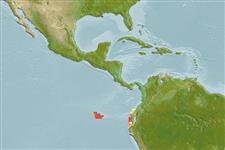>
Anguilliformes (Eels and morays) >
Myrocongridae (Atlantic red eels)
Etymology: Myroconger: Greek, myros, -ou = male of morey eel + Latin, conger = conger (Ref. 45335); nigrodentatus: Specific name refers to the internal dark pigment of the jaw and intermaxillary teeth..
Environment: milieu / climate zone / depth range / distribution range
Ecologie
marien demersaal; diepte 50 - 250 m (Ref. 57763). Tropical
Eastern Pacific.
Grootte / Gewicht / Leeftijd
Maturity: Lm ? range ? - ? cm
Max length : 36.6 cm TL (female)
Korte beschrijving
Morfologie | Morfometrie
Dorsale zachte stralen (totaal): 298; Anale zachte stralen: 213; Wervels: 123. body rather robust, relatively short snout, teeth on intermaxillary, maxilla and dentary prominent and sharp, many with dark brown to black internal pigment; a single row of small teeth on vomer; a moderately large, almost horizontal slit-like branchial aperture; precaudal vertebrae 50.
Levenscyclus en paargedrag
Maturiteit | Voortplanting | Paaien | Eieren | Fecunditeit | Larven
Castle, P.H.J. and P. Béarez, 1995. Two new species of Myroconger (Anguilliformes, Myrocongridae) from the Pacific Ocean. Cybium 19(3):211-222. (Ref. 26785)
Status op de Rode Lijst van het IUCN (Ref. 130435)
Gevaar voor de mens
Harmless
Gebruik door de mens
Visserij: van geen belang
Meer informatie
Lokale namenSynoniemenMetabolismePredatorenEcotoxicologieVoortplantingMaturiteitPaaienPaaiaggregatiesFecunditeitEierenOntwikkeling van de eieren
Leeftijd/GrootteGroeiLengte-gewichtLengte-lengteLengtefrequentiesMorfometrieMorfologieLarvenLarvale populatiedynamiekRekruteringAbundantieBRUVS
ReferentiesAquacultuurAquacultuurprofielKweeklijnenGeneticaElectrophoresesErfelijkheidZiektesVerwerkingNutrientsMassaconversie
Tools
Speciale rapporten
Download XML
Internetbronnen
Estimates based on models
Preferred temperature (Ref.
123201): 13.7 - 14.8, mean 14.1 °C (based on 4 cells).
Fylogenetische diversiteitsindex (Ref.
82804): PD
50 = 0.5625 [Uniqueness, from 0.5 = low to 2.0 = high].
Bayesian length-weight: a=0.00102 (0.00046 - 0.00225), b=3.06 (2.88 - 3.24), in cm total length, based on all LWR estimates for this body shape (Ref.
93245).
Trofisch niveau (Ref.
69278): 3.7 ±0.6 se; based on size and trophs of closest relatives
Fishing Vulnerability (Ref.
59153): Low to moderate vulnerability (27 of 100).
